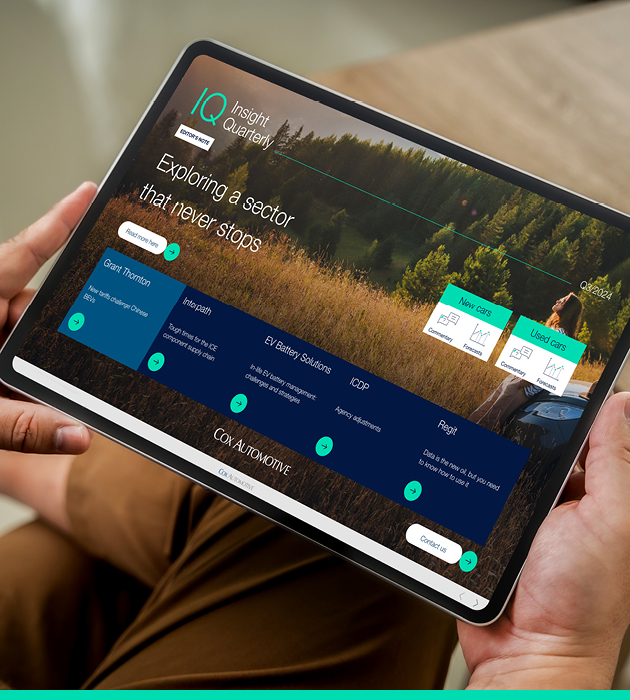- Artificial Intelligence helps businesses predict “better and faster”
- Automotive industry must take advantage of AI opportunities
- AI empowers automotive and enhances human potential, aiding predictions and decisions
- Data-driven AI transforms fleet, maintenance and development as connected vehicles reshape the industry
The extraordinary power of Artificial Intelligence (AI) won’t necessarily replace humans in automotive – but, if used wisely, will make them more powerful. That’s according to Dataiku’s Shaun McGirr, writing in Cox Automotive’s latest quarterly insight AutoFocus.
Summarising AI as machines capable of learning from data, to make predictions or take actions based on that learning, he insists the technology means businesses can predict “better and faster”. The latest and most notable forms of “Generative AI”, including ChatGPT, are large language model chatbots, trained on massive amounts of text and code. They are able to translate languages, write different kinds of content and answer questions in an informative way. Shaun says ChatGPT works so well that it is able to mimic human communication and has simply reduced the cost of predicting the next best word in a sentence to the point that they can mimic human communication.
“It is best applied to problems where summarising large bodies of text is a relevant solution,” he said. “The good news is that such use cases exist throughout automotive.”
Cox Automotive’s Insight and Strategy Director, Philip Nothard, said: “It’s clear that AI, in its various forms, is increasingly used by various industries. The pace at which it improves and is applied in the modern world brings uncertainties and efficiencies. The automotive industry must take advantage of AI's opportunities to develop and improve how vehicles are built and maintained throughout their lifecycle.”
Was AI oversold in automotive?
Dataiku’s Shaun thinks AI in automotive may have been ‘oversold’ in recent years, a prime example being the constant hype around self-driving cars, whose introduction has always seemed to be “just around the corner”. However, the difficulties of guaranteeing their safety have consistently helped to put the launch on the back burner.
Shaun said: “Thankfully, as often happens with innovation, the ‘moonshot’ application (self-driving cars) has spawned more mundane applications that are now standard: lane-keep assist, radar-assisted cruise control and all manner of warning systems.”
He adds: “Another spin-off benefit has been the richer data collected about everything from traffic to driver behaviour to vehicle performance, which presents challenges. Manufacturers have decades of experience putting technology in the vehicle but are relatively behind other industries in making their data investments pay off across the entire company.”
Data generated by ‘connected’ vehicles and utilised by AI helps with areas including fleet location and predictive maintenance, but also drives product development, according to Shaun.
Dataiku company GE Aviation has used such technology to cut product design times in half while increasing fuel efficiency by 7% in a piston engine. Their AI system used the results of previous (and costly) full-blown simulations of the part in question to train a neural network that could predict the simulation results of potential designs.
He said: “Such a drop in the cost of predicting successful designs allowed designers to do much more: pre-testing millions of potential designs in minutes, distilling all that human knowledge and discovering an edge. This approach is already widespread in pharmaceutical and materials design but has incredible potential in automotive to reduce the weight of every part while increasing its strength.”
The rise of ChatGPT
Shaun concludes that the rise of Chat GPT has put AI on everyone’s agenda, as automotive, like other industries, has sought ways to improve the speed and efficiency in its ways of working as it faces many regulatory and economic challenges. Shaun says the sector should use the rapidly dropping cost of predictions (i.e., improvement and affordability of AI) to make more decisions.
“It (automotive) must not be too proud to admit it is a little behind. It should use the rapidly dropping cost of predictions to change decisions,” he adds. “In its favour is the extraordinary wealth of experience and knowledge, which, if made more flexible in combination with AI, will not replace humans but make them even more powerful.”
Philip Nothard said: “AI has already had a major impact on the automotive industry, transforming the way vehicles are designed, built and operated. And this past year has seen AI’s power surpass all expectations. Manufacturers will no doubt continue to utilise and adapt to that power and consumers too will benefit as AI is changing how they purchase vehicles, financing and insurance – among other things. Automotive may reportedly be behind the curve when it comes to implementing AI solutions but that will certainly change.”
Read the latest AutoFocus here.



